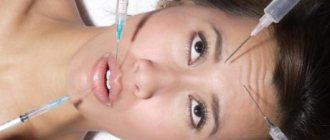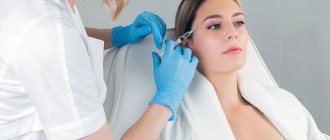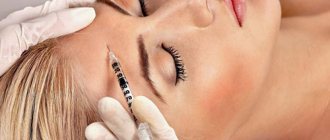Pharmacological effect
Lidaza is a drug that can be used for such a procedure. This remedy is used in the treatment of keloid scars, wounds, and ulcerative lesions.
- after administration of the drug, the breakdown of hyaluronic acid (a substance that seals connective tissues) is observed;
- Subsequently, scar tissue is split, swelling is reduced and the process of contracture development is inhibited.
This procedure is based on the method of electrolytic dissociation, in which the drug is split into ions in aqueous solutions. After an electric current passes through such a solution, the smallest particles of the drug will be activated and enter the human body. Once in the tissues of the body, the drug is evenly distributed and slowly absorbed into the lymph and general bloodstream.
The maximum concentration of the active substance will be in the place through which the medicine was administered (for example, the spine, neck, etc.). The absorption process can be influenced by various factors such as:
- ion size;
- patient's age;
- duration of the electrophoresis procedure;
- degree of disease progression;
- the general condition of the patient's body.
The procedure helps to provide anti-inflammatory, analgesic and calming effects. There is a normalization of blood supply and delivery of necessary biologically active substances to the tissues of the body.
Features of endonasal electrophoresis
The current passes through the tissues of the body in the direction from one electrode to another. On its way there are obstacles that have different electrical conductivities. So in the eyeball, the lowest electrical conductivity is in the skin of the eyelids, and the highest is in the intraocular fluid. To overcome low conductivity tissues, high current energy is required. As a result, galvanic exothermic reactions develop, the acidity of the environment changes, and active metabolites and enzymes are formed. As a result, microcirculation improves, and a burning sensation appears in the area affected by the current.
Simultaneously with the increase in blood and lymph flow, the so-called resorption capacity of tissues increases and the permeability of the blood-ophthalmic barrier increases. As a result, the effective dose of drugs is reduced compared to the parenteral route of administration.
The cornea of the eye is an excellent semi-permeable membrane that allows ions of matter to pass into the eyeball. The concentration of the drug inside the eye becomes high enough for the treatment to produce the desired result. The effectiveness of the influence on pathological foci is prolonged.
Indications
Electrophoresis with Lidase is used in the treatment of a large number of diseases, including disorders of the musculoskeletal system. Indications for physiotherapeutic procedures include complex treatment:
- osteochondrosis;
- osteoarthritis;
- joint contractures;
- degenerative changes of the spine.
Read also….
Symptoms and diagnosis of gonarthrosis of the knee joint The drug can be used to eliminate various inflammatory changes in the joints, including the development of ankylosing spondylitis.
Electrophoresis with lidase for the treatment of scars - does this technique help?
Working with scars is considered one of the most labor-intensive areas of aesthetic medicine. A prominent place in it is occupied by physiotherapeutic procedures, used both independently and as part of complex therapy.
Electrophoresis with lidase is an accessible and inexpensive method of treating fresh hypertrophic and keloid scars, which can be used for patients of any age, including children. However, it is not recommended to “prescribe” it to yourself - there are a number of nuances and application features that can reduce all efforts to zero. In what cases will this procedure be truly effective? How many sessions do you need to complete to see results? What defects can be cured using this method? Find out all the most important things on TecRussia.ru:
↑ How does this drug work and in what cases does it help?
Lidase is the trade name for hyaluronidase, an active enzyme that is capable of breaking down hyaluronic acid, as a result of which serious changes occur in the surrounding tissues: the permeability of cell membranes and vessel walls for water molecules increases, swelling subsides, blood supply improves, and scarring and fibrous formations become less dense.
Due to these properties, the drug is well suited for working with two types of scars - hypertrophic and keloid, i.e. those that are formed by overgrown connective tissue cells and protrude above healthy skin. At the same time, in the case of atrophic (sunken) scars, the effect will be exactly the opposite: they will “sink” even more and become visually more noticeable.
↑ What is electrophoresis and how is it done
There are two main ways to administer lidase:
- Injections directly into scar tissue. They give a quick, pronounced effect in just 1-3 sessions, but have a very serious drawback: even a slight excess of the dosage can lead to a noticeable retraction of the scar and the formation of a new cosmetic defect. As a rule, such injections are used when working with large and relatively old scars at the initial stage of treatment.
- Electrophoresis is the delivery of an active substance through the skin barrier using a low current. A much softer, well-controlled and completely non-invasive method, but it gives noticeable results only after a long course. It can be used both independently and to consolidate and enhance the results of previously made injections.
Technically, electrophoresis with lidase is carried out as follows:
- The doctor prepares a solution, the concentration and exact composition of which depend on the “age” and other individual characteristics of the scar (this may also include additional active ingredients, for example, ronidase), and then impregnates special pads with it.
- Next, an electrode connected to a current generator is fixed in each gasket. The entire structure is placed directly on the problem area of the body and a constant discharge is launched through it. It sounds scary, but we are talking about electricity of low strength and voltage, which is unable to cause any harm to the body.
- The session takes about 15-20 minutes. Subjectively, it is quite comfortable, only a slight tingling sensation is felt in the areas of contact between the pad and the skin. Immediately upon completion, the patient can go home.
The standard course ranges from 3 to 10 procedures, carried out at intervals of 1-2 days - their exact number depends on the type and size of the scar, as well as the body’s individual reactions to treatment. If necessary, it can be repeated after a break of several weeks.
↑ Main features of the use of electrophoresis with lidase in the treatment of scars
- The drug is most effective in the first 3-5 months after wound healing. For best results, it is sometimes alternated with collagenase. Scar formations older than six months respond to the procedure much worse, however, even in this case, after a full course, their appearance can noticeably improve and their size decrease.
- When working with hypertrophic scars, lidase can give the desired result without any additional effort, but in the case of keloids it is unlikely to be enough. The fact is that the growth of this type of scar is due to the constant increased activity of fibroblasts. There are a great many reasons for this process - from wound suppuration to the psychological state of the patient. It is impossible to eliminate these factors with medication alone. Here you should prepare for complex and, possibly, quite radical treatment - up to the use of steroids and surgical excision of problem tissues.
- Electrophoresis with lidase is considered one of the safest ways to get rid of scars; it is also indicated for children of any age, starting from infancy, and in many cases they see results much faster than adults - in just a few sessions. However, such treatment should only be prescribed to the child by a physical therapist or surgeon.
↑ How much does the procedure cost?
Physical therapy has traditionally cost patients less than injection or laser treatments. One session of electrophoresis costs about 150-300 rubles. A package of 10 lidase ampoules will cost an average of 500 rubles. At the same time, in many pharmacies this medicine is dispensed individually without any problems, so you can buy it exactly according to the number of sessions prescribed by the doctor (1 ampoule per 1 session). Thus, the total cost for the full course will not exceed several thousand.
What are the advantages of the method?
Among the advantages of this method of administration are:
- no pain;
- the active ingredient of the drug is activated slowly, the effect of the procedure lasts for 24 hours;
- the possibility of carrying out the procedure at home - only after agreement with the attending physician;
- minimal risk of complications, unwanted side effects, including allergies;
- the possibility of performing electrophoresis with Lidase directly at the site of inflammation;
- during electrophoresis, a smaller dosage of the drug may be required than with intravenous or intramuscular administration. This does not affect the therapeutic effect.
After administration of the drug, the active substance does not penetrate the gastrointestinal tract.
Contraindications
Attention! The use of electrophoresis in the acute course of the disease is contraindicated.
It is worth remembering that not all medications can be administered using electrophoresis. There are a number of restrictions to carrying out such a procedure:
- the presence of malignant neoplasms;
- development of intense bleeding;
- exacerbation or severe course of the inflammatory process;
- development of bronchial asthma;
- blood clotting disorder;
- severe dysfunction of the cardiovascular system: development of severe heart disease;
- individual intolerance to electric current or the active substance of the drug.
Lidaza is not recommended for use during pregnancy and during exacerbation of infectious diseases.
The essence of the method and the effectiveness of treatment
Electrophoresis is a type of physiotherapy, which is a combination of the properties of direct current and various medications.
Reference . The main medications used in electrophoresis include Lidaza, Eufillin, Karipazim, Hydrocortisone, Dimexide, Novocain, calcium, and B vitamins.
The essence of the method is the effect of electrical impulses on the body. They are generated by the device and have a therapeutic effect at the general and local levels. At the same time, the drug is administered percutaneously.
Thanks to this, the procedure can have the following therapeutic effect on the body:
- Elimination of inflammation, pain, swelling.
- Improved blood circulation.
- Normalization of muscle tone.
- Activation of the body's immune system.
- Acceleration of regeneration processes.
- Normalization of metabolic processes.
- Promoting the production of biologically active substances.
The method of administering medications using electrophoresis has a number of undeniable advantages:
- Painless.
- Minimal side effects.
- The long-term therapeutic effect of the administered medication is up to 20 days.
- Injection of the drug directly into the lesion.
- A small concentration of the drug, with which it is possible to achieve a high therapeutic effect.
An important advantage is the availability of such treatment , because equipment for carrying out this physiotherapy is available in almost every hospital.
Mode of application
Depending on the charges present, the drug can be administered through the negative (cathodic) or positive (anodic) poles. Lidase should be administered through the anode (positive) pole.
- The dosage of the drug Lidaza recommended by the doctor is dissolved in distilled water.
- The duration of an electrophoresis session can be up to 15 minutes.
- The course of treatment will depend on the degree of progression of the disease and ranges from 10 to 20 procedures.
- On the recommendation of a doctor, the technique is used in courses several times a year.
During therapy, the following types of current are allowed: galvanic, fluctuating, diadynamic, rectified. The doctor decides which currents can be used individually, taking into account the indications for using the procedure and the individual characteristics of the patient’s body.
How to dilute and use Dimexide and Lidaza
Tampons with Lidaza and Dimexide are used to improve blood circulation in the pelvis and quickly restore the mucous membrane. Dimexide is diluted with Lidaza in a ratio of 1:3. This treatment should be prescribed by a gynecologist. Too much concentration of Dimexide can cause burns.
For therapy, an aqueous concentrate with 10-30% of the drug is used. The water must be boiled. To get a 10% solution you need to take 2 ml of the drug and 18 ml of water. To obtain a 30% solution, you need to take 6 ml of water and 14 ml of medication.
Tampons with Dimexide are supplemented with Lidaza and are used to improve blood circulation in the pelvis and quickly restore the mucous membrane.
To make a tampon, you need to take a little sterile cotton wool and 20 cm of bandage. Cotton wool is placed in the middle of the bandage strip and 2 knots are tied along the edges. The ends of the bandage will help you remove the tampon. The procedures are carried out 2 times a day, morning and evening.










